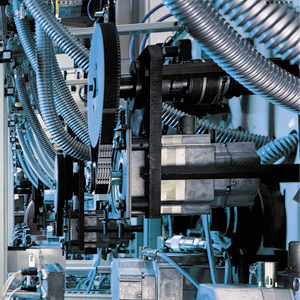Overview
ENG_107801.XML
MOTION‑CONNECT cables are suitable for use with many different types of machine tools and production machinery.
The following variants of MOTION‑CONNECT cable are available as fully-assembled power and signal cables or sold by the meter:
MOTION‑CONNECT 500
- Cost-effective solution for predominantly fixed routing
- Suitable for low mechanical loading
- Tested for traversing paths of up to 5 m (16.4 ft)
MOTION‑CONNECT 800PLUS
- Meets requirements for use in cable carriers
- Suitable for high mechanical loading
- Oil resistance
- Tested for traversing paths of up to 50 m (164 ft)
MOTION‑CONNECT 400 (only for SIMOTICS S-1FS2 motors)
- Extremely chemically resistant FEP jacket (especially against common cleaning agents and disinfectants used in the F&B industry)
- With integrated pressure compensation tube
- Not suitable for repeated bending stress!
Benefits
ENG_112959.XML
Pre-assembled MOTION‑CONNECT cables provide high quality and impeccable system-tested functionality.
SPEED-CONNECT
Connectors with SPEED-CONNECT quick-release locks enable fast, stable and reliable connections. All that is required to attain stable interlocking and a secure connection is less than a quarter turn of the lock nut of the connector. Tools are not required.
Cables with SPEED‑CONNECT connectors supplement the previous offering of MOTION‑CONNECT cables with full-thread connectors.
Application
ENG_116537.XML
MOTION‑CONNECT cables are intended for use in machines. They are not suitable for building technology applications or outdoor installation.
MOTION‑CONNECT cables have been tested in a cable carrier with horizontal traversing paths and have also been designed for this type of application. They are not self-supporting.
The pre-assembled cables can be ordered in length units of 10 cm (3.94 in) and can be extended, if necessary.
When cable lengths (basic cables and extensions) are determined for the systems and applications described in this catalog, the technically permissible maximum cable lengths (e.g. 25 m (82 ft)) specified in the catalog must be observed. Malfunctions can occur if longer cables are used. Siemens assumes no liability for correct transmission of signals or power in this case.
Compatibility between SPEED‑CONNECT and full-thread connectors
|
Connector on motor with external thread
|
Connector with cap nut on cable
|
Compatibility
|
|
SPEED‑CONNECT
|
SPEED‑CONNECT
|
✓
|
|
SPEED‑CONNECT 1)
|
Full-thread
|
✓
|
|
Full-thread
|
Full-thread
|
✓
|
|
Full-thread
|
SPEED‑CONNECT
|
–
|
1) If shocks and vibration can occur, an additional O-ring is recommended to prevent the connection from coming loose.

Function
ENG_112960.XML

G_NC01_XX_00289
The cables must be removed from the drum without twisting, i.e., the cables must be unwound and must never be lifted over the drum flange in loops.
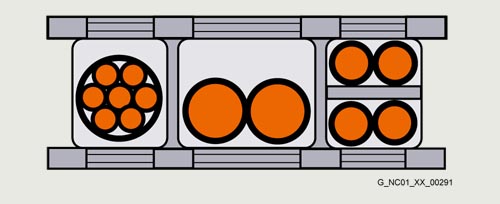
G_NC01_XX_00291
To maximize the service life of the cable carrier and cables, cables in the carrier made from different materials must be separated by spacers in the cable carrier. The spacers must be filled evenly to ensure that the position of the cables does not change during operation. The cables should be distributed as symmetrically as possible according to their weights and dimensions. Cables with very different outer diameters should also be separated by spacers.
When inserting pre-assembled cables into the cable carrier, do not pull at the connector, as this may damage the strain relief or cable clamping.
The cables must not be fixed in the cable carrier. They must be freely movable.
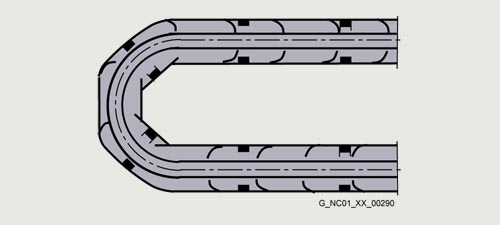
G_NC01_XX_00290
The cables must be able to be moved without applying force in particular in the bending radii of the carrier. The specified minimum bending radius must be adhered to.
The cable fixings must be attached at both ends at an appropriate distance away from the end points of the moving parts in a dead zone.
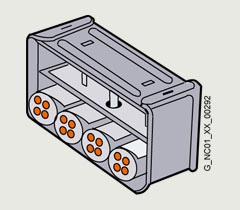
G_NC01_XX_00292
MOTION‑CONNECT cables are tested in a cable carrier. The cables are attached at one end by means of strain relief to the moving ends of the cable carrier. Strain relief is applied over a wide area of the cable jacket surface without crimping the cable.
Cables must be installed in accordance with the instructions supplied by the cable carrier manufacturer.
Note:
If, for example, pre-assembled cables are installed in a cable carrier in such a way that the connector would inhibit assembly, pre-assembled cables without assembled connector can also be supplied (power and signal cables 1)). Depending on the version, the contacts of the cables are crimped and the connector is supplied separately. After installing the cables, the customer assembles the connector.
In case of vibration load and with horizontal or vertical cable entries, we recommend that the cable is additionally fixed if between the cable strain relief on the cable carrier and the terminal at the motor part of the cable is hanging loose or is not routed. To prevent machine vibrations being transmitted to the connectors, the cable should be fixed at the moving part where the motor is mounted.
Representation in connection overviews
1) Not for DRIVE‑CLiQ signal cables.

Characteristic curves
ENG_252658.XML
Characteristic curves for MOTION‑CONNECT 800PLUS
The blue area beneath the characteristic curve represents the potential range of use for the cables. The characteristic curves represent the tested operating points.
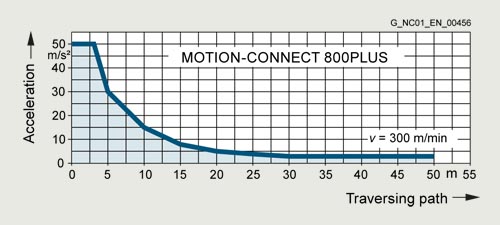
G_NC01_XX_00456
Permissible acceleration for MOTION‑CONNECT 800PLUS signal and power cables up to 16 mm2
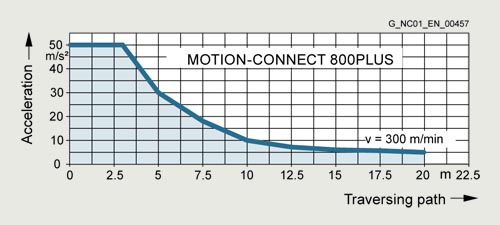
G_NC01_XX_00457
Permissible acceleration for MOTION‑CONNECT 800PLUS cables of 25 mm2, 35 mm2, and 50 mm2
More information
ENG_119177.XML
Current carrying capacity for power and signal cables
The current carrying capacity of PVC/PUR-insulated copper cables is specified in the table for installation types B1, B2, C, and E under continuous operating conditions with reference to an ambient air temperature of 40 °C (104 °F). For other ambient temperatures, the values must be corrected by the derating factors from the table.
|
Cross-section
|
Current carrying capacity
rms AC 50/60 Hz or DC in amps for installation type
|
|
|
B1
|
B2
|
C
|
E
|
|
mm2
|
Single-core cables in conduits or installation ducts
|
Multi-core cables in conduits or installation ducts
|
Multi-core cables, vertically or horizontally on walls/open, without conduits and installation ducts/with contact
|
Multi-core cables, horizontally or vertically on perforated cable racks/open, without conduits or installation ducts/with contact
|
|
Electronics1)
|
|
0.2
|
–
|
4.3
|
4.4
|
4.4
|
|
0.5
|
–
|
7.5
|
7.5
|
7.8
|
|
0.75
|
–
|
9
|
9.5
|
10
|
|
Power2)
|
|
0.38
|
6.2
|
6.1
|
7.1
|
7.4
|
|
0.75
|
8.6
|
8.5
|
9.8
|
10.4
|
|
1
|
10.3
|
10.1
|
11.7
|
12.4
|
|
1.5
|
13.5
|
13.1
|
15.2
|
16.1
|
|
2.5
|
18.3
|
17.4
|
21
|
22
|
|
4
|
24
|
23
|
28
|
30
|
|
6
|
31
|
30
|
36
|
37
|
|
10
|
44
|
40
|
50
|
52
|
|
16
|
59
|
54
|
66
|
70
|
|
25
|
77
|
70
|
84
|
88
|
|
35
|
96
|
86
|
104
|
110
|
|
50
|
117
|
103
|
125
|
133
|
|
70
|
149
|
130
|
160
|
171
|
|
95
|
180
|
165
|
194
|
207
|
|
120
|
208
|
179
|
225
|
240
|
1) One control circuit pair.
2) One symmetrically loaded three-phase AC cable.
Derating factors for PVC/PUR-insulated power and signal cables
|
Ambient air temperature
°C (°F)
|
Derating factor
acc. to EN 60204‑1, Table D.1
|
|
30 (86)
|
1.15
|
|
35 (95)
|
1.08
|
|
40 (104)
|
1
|
|
45 (113)
|
0.91
|
|
50 (122)
|
0.82
|
|
55 (131)
|
0.71
|
|
60 (140)
|
0.58
|
Note:
Derating for MOTION-CONNECT 400 analogously according to EN 60204-1.

Taking the tour will redirect you to our new platform. You can always come back either by hitting back button on the browser or by opening the URL again.
